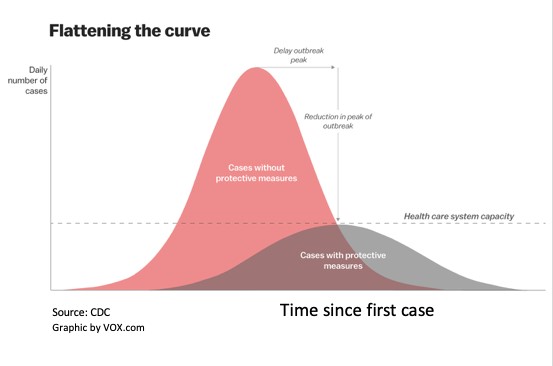Recently, the epidemiologic term “flattening the curve” has been widely cited in the media, including a recent article in the Omaha World-Herald. I want to tell you what this means and why it is critically important for the health of Nebraskans.
There are four things to understand in the graph below.
- It is a plot of the daily number of cases against time
- The red curve is if there are no preventive measures to stop disease in the community
- The gray curve is if you use preventive measures to limit the rate of new cases
- The dotted line is the hospital capacity in a community

What does this tell us?
- If we do not take protective measures, we will be unable to care for those needing hospitalization. There are not enough beds, ventilators or other services for the critically ill
- Protective measures delay the outbreak peak
- Protective measures can diminish overall cases and the health impacts
- Importantly, with protective measures hospitals have enough capacity to take care of patients
Here is important math:
One infected person infects about 2.5 others; they in turn infect 2.5 each. So very quickly, that one person results in 10 cases in the community – and that continues. The current estimates suggest that if 100 people become infected, five will need to be hospitalized. That seems like a small number, but in the state of Nebraska, over an 8-week period that is between 30,000 and 90,000 additional hospitalized people and 12,000 to 20,000 of those might need an intensive care bed. Key point: There are not that many hospital beds in Nebraska. We will be unable to provide lifesaving care for people with this infection. Do not forget, in addition to the patients with this new infection your hospital still must take care of those with heart attacks, cancer, strokes and many other conditions. Most of the hospitals in our community are “full” as I type this.
What must be done?
We need to reduce the transmission of this virus in the community. The advice from public health leaders should be followed:
- If you are ill, avoid contact with others
- Wash your hands
- Avoid touching your face
- Stop attending large group gatherings. That might be church services, community events, sporting events, etc. and follow the advice of leaders and public health officials on schools and other gatherings. What is large? Anywhere you cannot be approximately six feet from another person. In addition, efforts to protect the most vulnerable individuals in nursing homes need to be intensified
- If you are an employee who can work from home, discuss doing so with the management of your company
Every hospital in our community is actively planning and collaborating with each other and with the public health department. However, we need your help to “flatten the curve.”



